THE Eskimo have always been a subject of the highest interest, not only to the popular mind, but also to the student of American ethnology. No other group of American Indians differs as radically in so many respects from the average of the race. This grouping of the Eskimo with the Indians will no doubt surprise some, which is quite understandable, for many authorities have considered the Eskimo as a separate people. The best anthropologists of today, however, basing their conclusions on more detailed and accurate studies of Indian and Eskimo physical types and peculiarities, class the Eskimo as a sub-type, although the most variant branch, of the American race. In some respects he approaches more closely the general Asiatic type than does the average American Indian, but generally his physical peculiarities are his own, though some of them seem to hark back to earlier and more primitive human types. In material culture, likewise, he seems to be almost unique, having very few points of contact with the neighboring Indian tribes. Some of the Asiatic tribes of the adjacent regions of Siberia do, indeed, show considerable resemblance to the Eskimo in culture, but the consensus of scientific opinion is that these influences have come to them from the American Eskimo, not vice versa. That the Eskimo, thus comparatively isolated, physically and culturally as well as geographically, should so strongly attract both the fancy of the people and the interest of the scientist, is therefore not surprising.
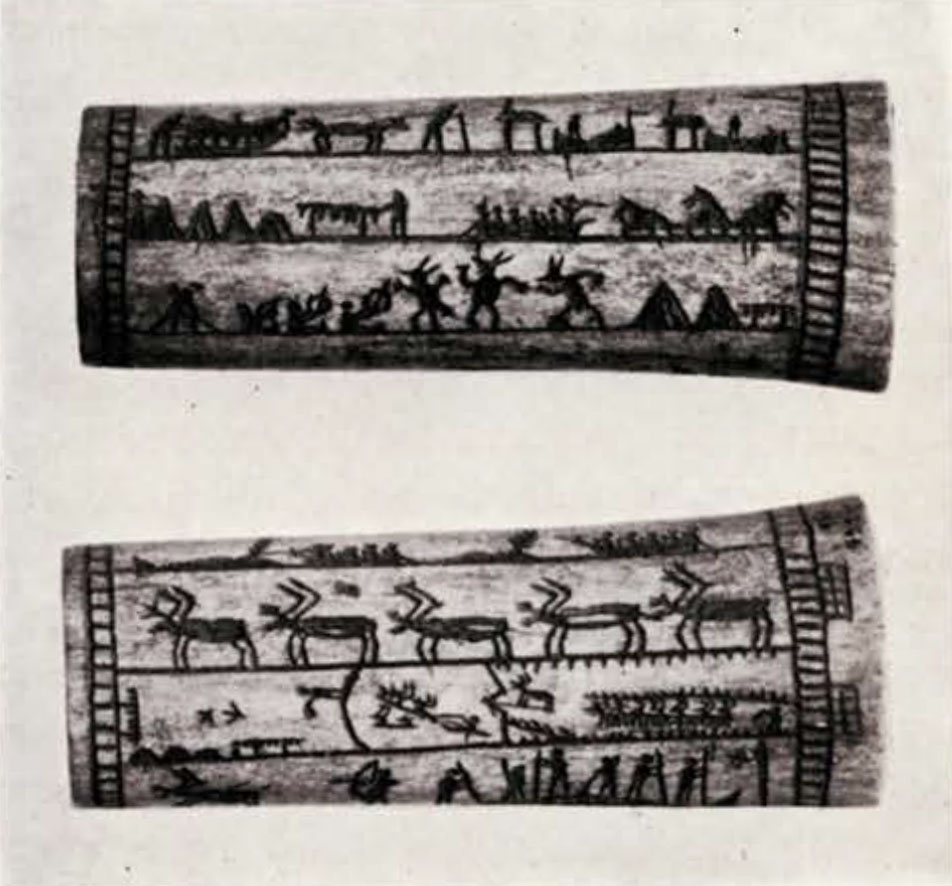
Museum Object Number: 42211
Image Number: 12104
The far-flung habitat of the Eskimo stretches, or originally stretched, over the enormous extent of five thousand miles, from the Strait of Belle-Isle at the northern tip of Newfoundland to the westernmost islands of the Aleutian Archipelago. In the east they have left traces even further south, perhaps to Anticosti Island in the Gulf of St. Lawrence. Groups of them are found on the Siberian mainland just across Bering Strait, others in the Arctic islands north of Canada, and still others in Greenland. One group at Smith Sound in northern Greenland in latitude 78° occupies the northernmost permanent settlement in the world, the village of Etah, inhabitants of which have aided and accompanied most of the Polar explorers, and evidences of their former summer camps have been noted as far north as latitude 82°, not much more than five hundred miles from the North Pole.
Yet in spite of this extensive range of territory the Eskimo form a remarkably homogeneous group. Many Indians farther to the south, separated by no more than a mountain range, exhibit greater differences in language, physical type and culture than do Eskimo from the opposite limits of their habitat. Minor differences, of course, exist, but throughout this immense area the essential homogeneity of this people in all respects is remarkable. This fact appears to involve three deductions, an identity of origin, a relatively late dispersion, and a pronounced conservatism. The last inference is obvious to all travelers in the Eskimo region; the others are not yet proved but are generally accepted.
The Eskimo were the first American natives to come into contact with Europeans, the pagan Norsemen who met them in Greenland about the close of the tenth century; and it is generally believed that the “Skraelings” of the sagas of Eric the Red, Leif Ericsson and Thorfinn Karlsefni who fought with the Vikings in the legendary Helluland, Markland and Vinland, were Eskimo. This name, formerly generally employed in the French form Esquimaux, is supposed to be derived from the term Eskimantsic, which was applied to them by the Abnaki Indians, who were then their neighbors. This means “the eaters of raw flesh,” and alludes to their practice of eating some kinds of meat, especially whaleskin, uncooked. Their name for themselves is Inuit, meaning, as is the case with many Indian tribal names, “people” or “men.”
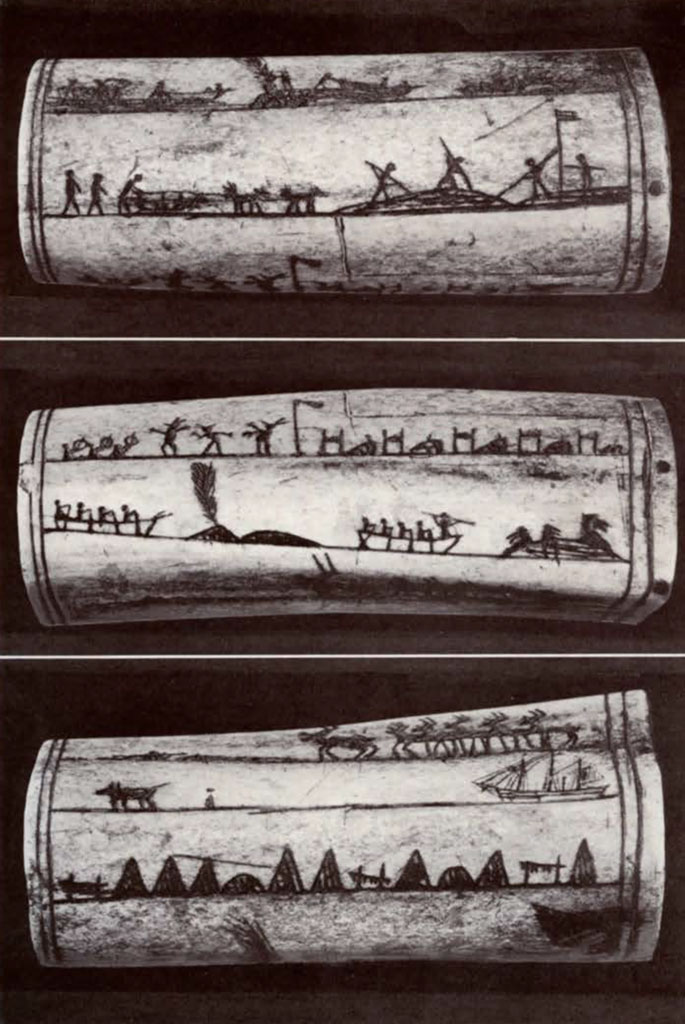
Museum Object Number: NA4251
Image Number: 12103
Despite the severity of his environment, the Eskimo leads a relatively comfortable life, far more endurable than that of his immediate neighbors in the woods to the south, the Indians of the Athabaskan and Algonkian groups. These latter are frequently or generally miserable, cold, hungry and possessed of a poor culture, ill adapted to their environment. The Eskimo, on the other hand, has conquered his environment, adapted himself to it and to some extent it to himself, and has produced dozens of special inventions and tools to meet his peculiar requirements. Many of these are for their purpose superior to the products of civilization; and, except in rare cases of failure of food supply, the Eskimo lives a relatively comfortable and happy life.
All northern explorers speak in the highest terms of the Eskimo, their magnificent physical development, intelligence, native inventive ability, sturdiness and independence, good-humor, hospitality and other admirable qualities, and most of them add a prayer that they may long be preserved from the civilization which, led by trader and missionary, is rapidly engulfing them and bringing about their physical and moral degradation while considerably diminishing their numbers. The missionary may undo some of the harm done by white outcasts from civilization, but if the native could be kept entirely from all contact with civilization, so much the better would it be for him.
Probably no people in the world are so maritime in habit as the Eskimo; they are exclusively a littoral people, never venturing more than fifty miles from the sea. The ocean and its inhabitants
supply the Eskimo with practically all his necessities of life, even his wood, such as he gets, being generally driftwood cast on the shore.
Art plays an important part in the life of the Eskimo and he takes a craftsman’s pride in decorating many or most of his implements, tools and household goods. Wood being scarce, his most available and efficient vehicle for the expression of his artistic urge is ivory, occasionally fossil ivory from the tusks of buried mammoths of prehistoric ages, sometimes the tusks of narwhals, but far more often the clear, creamy ivory supplied by the tusks of the walrus. This he carves into many tools and ornaments which he decorates either with carvings in relief or in the round, or by engravings.
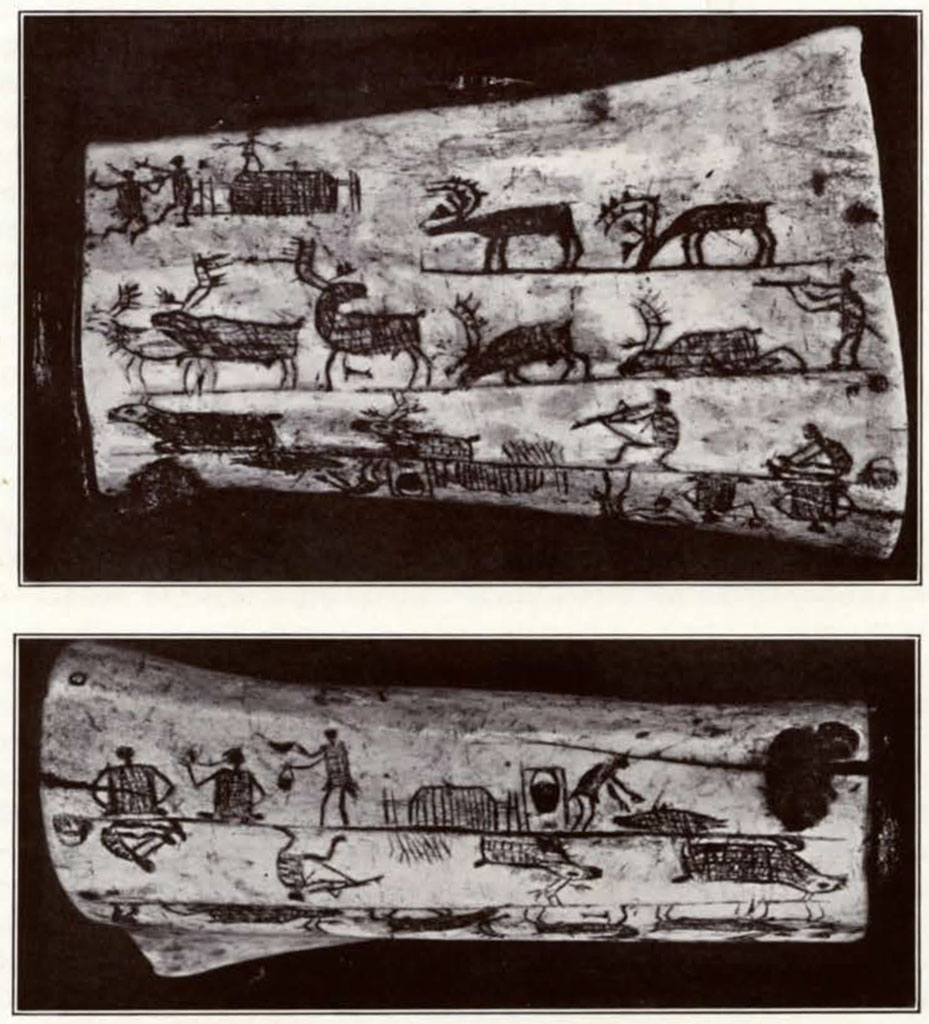
Museum Object Number: 42587
Image Number: 12105-12107
Eskimo engravings on ivory are objects worthy of interest for their unusual artistic merit. Primitive art in general is not naturalistic except in its early stages. While it may begin as such, it rapidly becomes conventionalized, stylicized and geometric. and a native, asked to draw a pictorial representation, usually produces a scrawl which would be the despair of any third-grade teacher. In the history of art three primitive “schools” stand out prominently, that of the Magdalenian cavemen of Europe, that of the Bushmen of South Africa and that of the Eskimo. All are noteworthy, considering the limitations of their technique and vehicles for expression, for a feeling for proportion and composition, and especially for the naturalness and liveliness of action portrayed by a very few properly placed strokes.
It was this close resemblance between the arts of the Magdalenian palæolithic cavemen and of the Eskimo more than anything else, although he also noted resemblances in manners and customs, implements and weapons, which led Sir W. Boyd Dawkins, one of the most eminent authorities on “Early Man in Britain,” to conclude in his book of that title that the Eskimo represent the remnants of European palæolithic man, driven out of Europe by later invaders. More recent investigators, amassing additional evidence, have not been able to agree with the great British archæologist in this view. They find the Eskimo physical type markedly different from that of the European primitive artists and more similar to the American type, that the implements and weapons are only superficially similar and, to cap the climax, they have decided that Eskimo graphic art, that is to say the pictorial art expressed in engraved ivory, is a phenomenon of late occurrence which probably developed since the first contact of the Eskimo with Russian explorers and settlers little more than a century ago.
The proof of this theory, upsetting Boyd Dawkins’s sensational hypothesis, is that such engraving is found only among the Alaskan Eskimo, being quite foreign to the Central, Greenland and Labrador Eskimo, and that excavations in Eskimo sites abandoned before the coming of the Russians produce no examples of pictorial engraving. Even within the area in which engraved ivory objects are found there is great variation, the best work being found immediately to the south of Bering Strait as far as the Alaska Peninsula, including Bristol Bay, Norton Sound and the territory between the Yukon and the Kuskokwim rivers. Good work is done in Kotzebue Sound just north of Bering Strait, but from here the work deteriorates until it is considerably inferior (according to the principal authority on the topic) at Point Barrow, the northernmost point of Alaska on the Arctic, which is practically the easternmost extension of the industry. These facts point directly to the conclusion that the practice of making pictorial engravings was not native to Eskimo art but is a development of the last century or two, the initial incentive having been supplied by contact with the first Russian colonists. That they were willing and able to adopt a foreign means of expression and to develop and adapt it to their own culture and nature speaks highly for the native ability and character of the Eskimo.
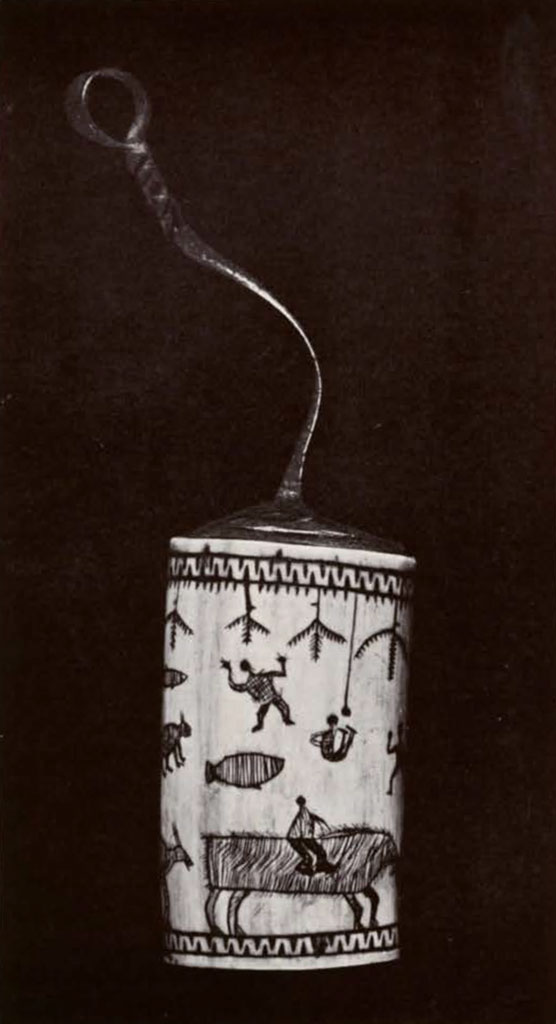
Museum Object Number: NA9192
Image Number: 12108b, 12109
The engravings of the Alaska Eskimo are generally executed on the hard, smooth, creamy ivory obtained from the tusks of the walrus, Rosmarus obesus, much less commonly upon the antler of the woodland caribou or American reindeer, Rangifer tarandus caribou, and occasionally upon bone. The antler is by nature especially suited for caskets and boxes, such as trinket, tinder or snuff-boxes, but is of a darker and more grainy nature than ivory. Of the latter are made most of the implements of the Eskimo, but naturally only the larger objects with a good deal of relatively flat surface are suitable for the engraving of pictorial figures and scenes. Among these are especially numerous the short bows employed in twirling the drills used both for perforation and in making fire, the handles of bags and buckets, and the tobacco pipes, the last being modelled on the Asiatic type. Smaller objects, less often decorated, are knife-handles, combs, bodkins, needlecases, arrow-straighteners, reels for fishing lines, and similar implements.
In the making of an ivory implement, such as a bowdrill, the tusk is generally sawed or split longitudinally into quarters, cut and carved, ground, smoothed and polished, drilled and etched. Today, tools of iron or steel are employed, though many of these are made by the natives themselves from nondescript pieces of iron, but in earlier days the cutting and carving were done with quartz crystals, the grinding with stone, the smoothing with sand, the polishing with another piece of ivory and the engraving and drilling with bits of flint or chalcedony. The incised lines were then blackened with a sub-stance composed of charcoal made from burnt grass mixed with oil. The most recent work is apparently blackened with graphite, perhaps from lead-pencils obtained from the traders.
The figures engraved are frequently purely decorative, consisting of repetitions of somewhat conventionalized figures of animals, houses and similar objects, but more often they are scenes from everyday life. These are generally hunting scenes, but often dances, religious observances or other activities are portrayed. In fact an excellent picture of Eskimo life could be obtained merely by the study of the engravings on any large collection of these objects. Probably the decoration was executed purely for aesthetic reasons, solely from a desire to beautify personal possessions. It has never been suggested that the decorations employed had any magical value or augmented the potency of the implement. The scenes portrayed may sometimes be purely imaginary but more often, probably, they are the record of hunts or other adventures participated in by the owner. “Hunting records” is a name frequently applied to them.
The University Museum possesses a rich collection of Eskimo engraved implements, the best of which are illustrated in the accompanying plates.
Probably the most interesting of these objects are the two boxes of antler, Nos. 42211 and NA-4251, figured on pages 249 and 251. The former is from Point Barrow, Alaska; the latter is without notation of provenience, but it is so similar in every respect that it must hail from the same neighborhood. They were used as receptacles for needles and thread, thimbles, beads and trinkets, and knickknacks of every description.
Specimen 42211 is decorated with eight short scenes engraved on parallel base lines. The first shows a dog-sled approaching a village. The sled is piled with a load of indefinite nature, on which two figures are riding while another pushes from behind. The dog is assisted by a man with a staff. To the right are seen two houses of the semi-subterranean winter type, each with a man on the roof, while beside each house is the scaffold on which food supplies are kept out of the reach of predatory wild animals and dogs.
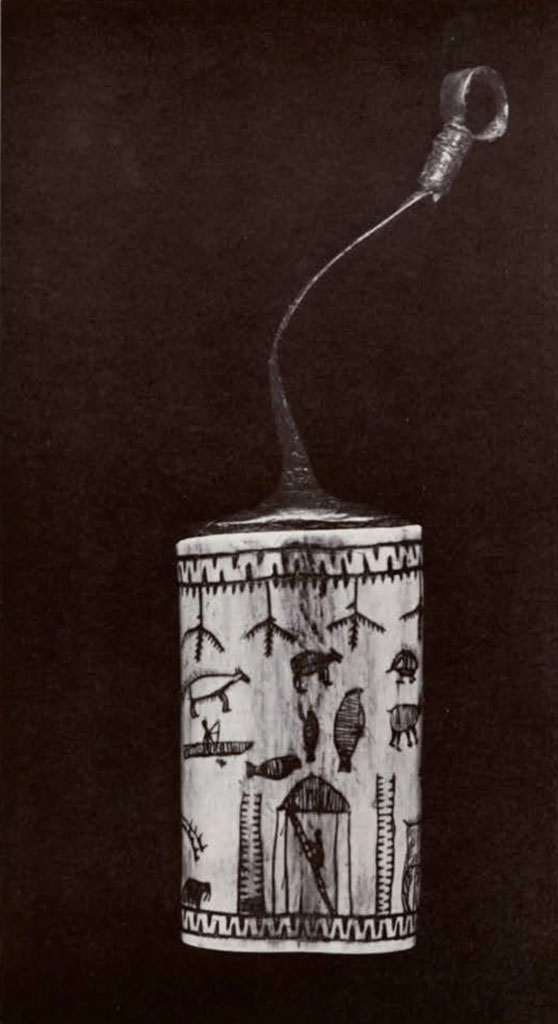
Museum Object Number: NA9192
Image Number: 12108b, 12109
Below this is a summer scene. The conical objects to the left are temporary summer houses erected at the hunting grounds and beside these is a rack upon which meat and fish are dried for winter consumption. To the right, an umiak or large skin boat is attacking three walruses upon an ice-floe. Of the six occupants, the leader is poising his harpoon, the steersman is dragging his paddle and the other four are probably paddlers, although paddles are shown in the hands of only two.
The following scene is one of the most interesting of all and apparently portrays a religious dance or shamanistic ceremony. To the left, two figures lean against each other, but whether they are wrestling, dancing or are otherwise engaged is uncertain. Next, three seated figures are beating the large discoidal one-head drums or tambourines which in North America are typical of the Eskimo alone, while three figures are caught in the -lifelike postures of a vigorous dance. They are apparently wearing masks which depict some long-eared animal and one of them wears a tail. At the right are seen two summer houses and a drying rack. The dance portrayed is obviously of the type of the “wood” or “tree” dance of which Murdoch says:1 “A row of old men beat drums and sang, while the performers chanted a monotonous song. Presently the bottom of the curtain was lifted and out crawled five men on all fours, wearing on their heads the stuffed skins of the heads of different animals—the wolf, bear, fox, lynx and dog.”
In the fourth tier, not shown in the illustration, is engraved a hunting scene in which are shown, in succession, a dead seal, a live seal towards which a hunter with a harpoon crawls, while overhead a bird is flying, a loaded sledge, another dead seal, and another sledge with an occupant.
A stirring whaling scene is shown in the next row, two realistic spouting whales being pursued by two umiaks. In the first boat the leader is harpooning the whale while two of the crew paddle and one steers; the second boat has not yet got within striking distance of the whale and the harpoon rests in its crotch in the bow while all the five occupants paddle and steer.
A line of five caribou forms the sixth row.
The seventh is less naturalistic and probably somewhat ideographic and is divided into three sections by curving or meandering vertical lines. At the left margin is apparently a drying rack in vertical position, followed by three summer houses and another drying rack, above which are several flying birds. The meaning of the human figure in horizontal position is doubtful. In the central section are portrayed five swimming caribou pursued by a man in a kayak, the man’s small skin hunting boat. He spears one of the caribou. To the right are seen the heads of seven swimming caribou while an eighth has climbed out on shore. The serrated lines probably represent land with vegetation. The purport of the figure of the man who holds in his right hand an object, exactly similar to that of the figure in the left cartouche, must be imagined; they may be urging the caribou towards the hunter in the kayak.
The final scene portrays to the left a caribou wounded by two arrows of the bowman behind it, and to the right six men flensing or cutting up a whale. The flag to the far right is the only foreign object represented in the whole decoration.

Museum Object Number: NA4384
Image Number: 12108a
Specimen NA-425 I similarly consists of seven parallel scenes, the first two apparently representing whaling activities. To the left appears a shore upon which a boat with three men is drawn up. Further to the left is an object of uncertain nature, composed primarily of two pairs of crossed poles, beside which a man stands; one may hazard a guess that a net is drying there. The object in the center of the scene is likewise of somewhat doubtful character. The same sign resembling a tree is employed by the Eskimo to represent the spouting of the whale, smoke, breath, wind and all similar phenomena. In this case, in view of the cylindrical object at the base tended by a nearby figure, it may be presumed that it represents the smoke of a fire, possibly a fire for trying out whale blubber. The object at the base may therefore be better interpreted as a rock than as a dead whale, especially since another boat with three occupants is being landed upon it. To the far right a whale is shown being harpooned by the leader of the crew of an umiak which has three other occupants, and above, though hardly visible in the illustration, and probably added at a later time and at an angle, is an exceedingly well-drawn picture of a small sloop with mainsail and jib, and with a steersman at the helm. This, together with the hat apparently worn by the central figure, the unusual object to the left and the absence of Eskimo houses on the shore, points to the conclusion that a scene of white whalers is here portrayed.
In the second whaling scene a sled of the high-railed type drawn by two dogs hitched in tandem and accompanied by three men approaches three figures who are apparently standing on a whale cutting it up. To the right is either another whale or a rock on which a flag is flying from a pole. As in the last figure of the preceding specimen, a flying flag appears to be a sign to other hunters that a whale has been caught and is being cut up.
Beneath, a dance almost identical with that shown in the preceding specimen is portrayed. The three drummers and three dancers with their long-eared masks are admirably shown and beside them is a pole or tree with the top broken and bent over. This probably represents the tree referred to by Murdoch from which the dance receives its name “Tree dance,” although the dance described by him was held indoors and the tree was represented by two tubular boxes hung from the ceiling. He continues his description: “They swung their heads from side to side in unison, keeping time to the music, uttering a low growl at each swing and shaking their rattle mittens. This they kept up for fifteen or twenty minutes, while the chant still went on, and the chief performer, with excited gestures, embraced the tree and rubbed his nose against it from time to time.” To the right of the dancers are seen five pairs of structures, the H-shaped objects being not goal-posts, but scaffolds for holding caches of food, and the lower objects probably being small temporary summer camp houses.
Next follows one of the commonest scenes of Eskimo life, a whale and walrus hunt.
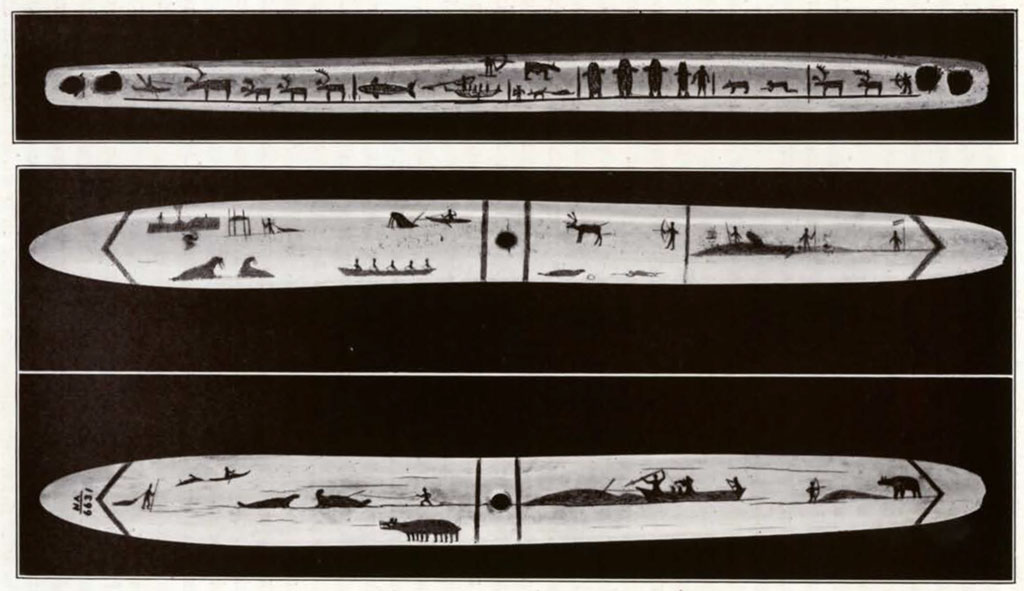
Museum Object Numbers: 41762 / NA6631
Image Number: 12095, 12100, 21191
A hunting scene on land and one of unusual artistic merit is next shown. Five caribou led by a big buck with spreading antlers, all of them with heads up in attitudes of surprise and attention, are looking towards a low hummock behind which a hunter with poised rifle is lying prone. The entire effect, attained by the use of the fewest possible strokes, is admirable.
The sixth scene is also an excellent performance, the auxiliary schooner to the right with its three masts, stack, jib, bowsprit and “dolphin-striker” being extremely well executed for a primitive artist. To the left, more carelessly drawn, are seen an animal, possibly a bear, and a man.
Finally we have a view of a row of dwellings and scaffolds for drying meat and fish. The houses, both of the high conical and the low hemispherical types, are the temporary summer shelters and tents which are erected at hunting grounds. Not a living thing is seen in this picture.
Another box of antler, also from Point Barrow, and probably used for sewing materials and personal trinkets, is No. 42587, illustrated on page 254. It has the appearance of considerable age, but the workmanship and decoration are inferior to those of the preceding specimens. The box is of oval cross-section, the decoration is almost entirely on one side, and the reverse shows only two unusually lifelike figures of caribou approaching a man with a gun, the latter poorly drawn and rather untypical both in technique and appearance.
On the opposite side are four parallel scenes, one of the marginal views being inverted. To the left in the first tier are shown three human figures, two of them evidently dancing together in a lively manner. The object held in the right hand of one, which he is apparently withholding from the eager grasp of the other, together with the adjacent building, which is of “civilized” type, may be taken as prima-facie evidence both that the manufacture of the specimen is recent, and that, one may hope, it antedated the passage of the Eighteenth Amendment. Another human figure is seen walking upon the ridge of the house.
To the right, at a slightly different level and unconnected with the foregoing, are engravings of two caribou. The antlers of these are especially well executed, and the animals are particularly well posed.
The next two scenes portray caribou hunts by men with guns. The technique and execution are only fair, but the attitudes of the wounded, startled, and fleeing animals are quite admirable.
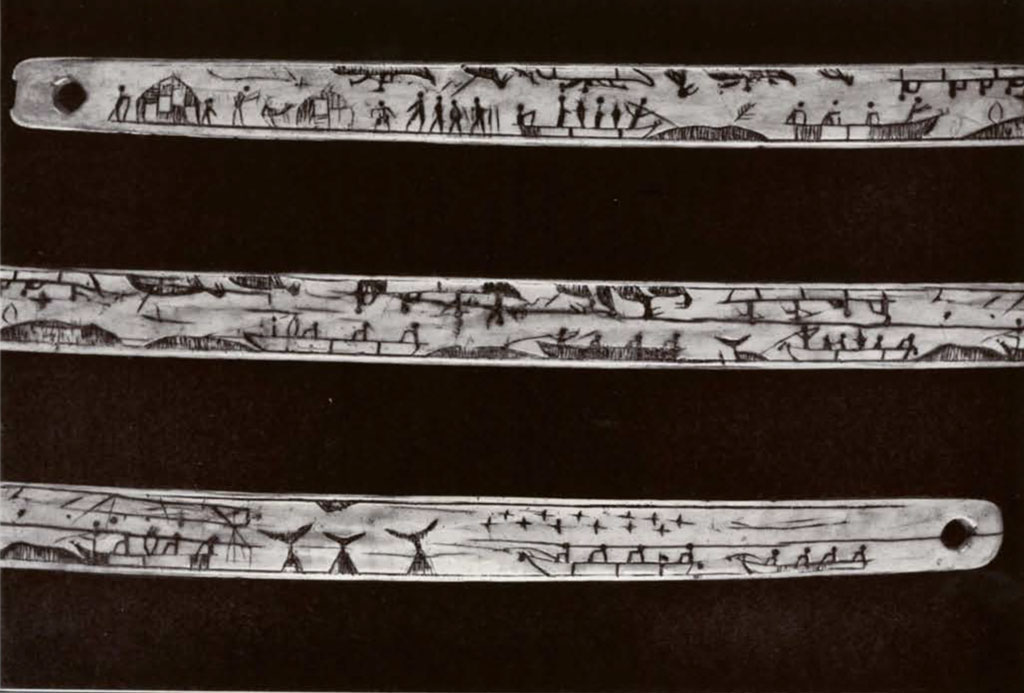
Museum Object Number: NA9387
Image Number: 12074, 12079, 12084
The fourth view, in inverted position, depicts a meal. To the left, two figures, probably men, are seated on the ground, one of them smoking a pipe with a long curving stem of the usual Eskimo form which was adopted, through the Russians, from the Asiatic type. Approaching them is another figure, probably a woman, bearing a bowl and a basket or pail, which doubtless contains food. The next object is difficult to identify, but is identical with one portrayed in the first scene on this specimen and there interpreted as a house on account of the figure of a man standing upon it. Both objects, however, seem to be upheld by four posts and it is quite possible that the artist intended to represent mosquito-bars, the canopies of netting which are stretched over beds. Mosquitos in incredible swarms are the bane and terror of the far north and no white man, trader or explorer, can endure life there without mosquito-bars, one of the few unalloyed benefits which civilization has brought to Greenland’s Icy Mountains and India’s Coral Strand. Beside this object is seen, cooking over a fire, a kettle supported on a framework. This method of preparing food is of course modern and was unknown to the Eskimo before the days of European contact when they possessed no metal. Murdoch reports that in 1881 metal kettles of various sorts were exclusively used for cooking and were called by the same name as the old soapstone vessels, but in earlier days food was probably cooked by the almost universal American custom of placing hot stones in water. This scene closes at the right with a figure apparently engaged in cutting up a seal. The number of objects foreign to native Eskimo culture, such as firearms, kettles and mosquito-bars, is evidence of the relatively late origin of this specimen and contrasts strongly with the absence of them in specimen 42211 and the others to be described later.
A small box presumed to have been employed as a snuffbox, NA-9192, is shown on pages 258 and 259. Its provenience is unknown. The material is polished walrus ivory, the engraving composed for the greater part of fine black lines. The daintiness of this engraving suggests its relatively late origin, since it is doubtful if such delicate work could have been done with other than a fine steel point. Other evidence pointing to the same conclusion is seen in the principal figure, that of a man riding on the back of a reindeer. The Old World reindeer and the American caribou are of closely related species, but the latter were never domesticated by the Eskimo, who were ignorant of the benefits to be gained by their domestication. Several efforts to introduce the industry resulted in failure. This was due to the opposition of the extremely conservative natives. At last the government succeeded, between 1892 and 1902, in inducing the Alaska Eskimo to breed, train, use and slaughter reindeer introduced from Asia. As a result, in 1924, seventy per cent of the 350,000 reindeer in Alaska were owned by Eskimo and the exportation of reindeer meat to the Pacific Coast of the United States and Canada became an important industry.
The figures on this engraved specimen appear to be without any intentional grouping or coherent arrangement, consisting mainly of animals, not especially well drawn, among which may be identified the caribou, seal, fish, bear, wolf, porcupine, walrus and a bird. Several human figures are portrayed, one of them, as already noted, mounted on a reindeer or caribou. Three of them are apparently concerned in a fight. Boxing, or serious fighting with the fists, is as foreign to the Eskimo as it is to all non-Anglo-American peoples, but may have been adopted in recent years by the younger generation. That seems to be the obvious interpretation of the group. The figure to the right is posed in a decidedly pugilistic position while the central one executes a flop which might grace today’s newspaper comic strip. The individual to the left may be registering joy or consternation at the outcome of the encounter. The vertical line with a ball at its lower end which hangs just above the central figure is of doubtful import, as is the row of trifurcating inverted tree-like objects at the top. The latter may be purely decorative.
A specimen somewhat similar in art and technique, No. NA-4384, is reproduced on page 261. It is from Wainwright, Alaska, a settlement on the Arctic coast a short distance, as distances are reckoned in Alaska, southwest of Point Barrow. It is catalogued as a needlecase, but if it is one it has lost the thick leather thong which fills the central bore of a needlecase and into which the needles are stuck. In effect it is a long, slightly tapering, octagonal ivory bead. Only one of the eight facets is decorated, this with a scene engraved with fine hair-lines much like the preceding object. In this specimen also, both the fineness of the lines and the concepts indicate a late period of manufacture. Beside a winter house with a food scaffold stands a man leading a reindeer which is drawing a sledge, the driver pointing towards the house and evidently urging on the beast. Such a scene would have been impossible in Alaska more than thirty years ago. To the right are two human figures, admirably done as regards bodily proportions and pose, which resemble strikingly the human figures in the previous specimen. The impression given by them, however, is that of ball players rather than of boxers.
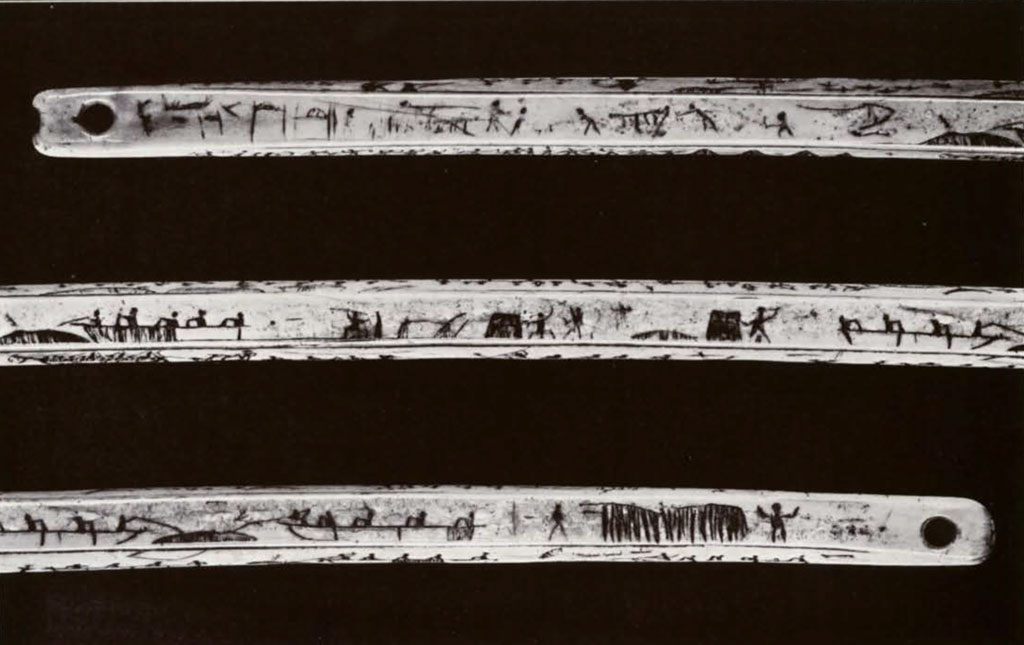
Museum Object Number: NA9387
Image Number: 12072, 12076, 12081
On page 264 are shown two views of a specimen, NA-6631, from Point Barrow, with figures and scenes engraved in unusually fine lines. Though catalogued merely as a “hunting record” it is obviously an implement for some purpose, but the published works upon the Eskimo of this region mention no object of this type. It is of smooth, creamy ivory and measures fourteen inches in length. Somewhat bow-shaped, one side is convex from end to end and slightly convex from side to side, while the other side is markedly convex from side to side and concave from end to end. In the center is a drilled hole. Although the general effect is one of relatively recent manufacture, the scenes portrayed are purely Eskimo and only one of them implies civilized influence, in the employment of a firearm.
The concave side may be considered as portraying six different scenes by land and sea and on the ice. In one of these a hunter with bow and arrow pursues a caribou into which he has already shot two arrows, while below a reclining hunter edges himself slowly and cautiously towards a seal. The figures are unusually lifelike. The circle beneath the head of the seal doubtless represents one of the breathing holes which seals maintain in the ice and around which they bask and are awaited by the hunters. The other scenes, including a whale-flensing, present no features that have not already been described.
The convex side is divided into two halves, right and left, in each of which are portrayed several hunting scenes, without apparent coherence and yet without separation. The greater part of the left half is occupied by a lively scene in which a hunter has cast his harpoon into a large seal beyond which another barks menacingly. On the lower margin stands a ferocious chimera, resembling a bear, but having ten legs. Eskimo art occasionally follows that of the Egyptians in economizing labor and space by portraying a line of animals in close conjunction and omitting some of the unessential features, but in such cases the proper number of heads is always shown. Obviously, ten legs can not be properly apportioned among any number of normal quadrupeds; either the artist erred or intended to represent a mythical monster. Such supernatural beasts, occasionally characterized by a superfluity of limbs, are known in Eskimo mythology, but none of the type of the present animal has been recorded. The oval eye of the beast, a feature noted on no other of the present specimens, augments the unnatural appearance of the monster.
The action of a whaling scene at the right is noteworthy. The bowman, having cast one harpoon, is in the act of plunging another. Behind him may be seen the inflated sealskins which are attached to the lines as floats to indicate the position of the whale after the attack. The man amidships appears to be shooting at the leviathan with a gun while in the stern the steersman keeps the bow hard against the quarry.
The art of this specimen is unusually good, the composition being well conceived and the bodily proportions, postures and actions very well portrayed.
The other specimen shown on this page, No. 41762, also from Point Barrow, is a bag-handle of walrus ivory, somewhat like the preceding specimen in shape, but narrower, thicker and with twin holes at either end. Moreover, the decorations, on both sides, are filled with a brick-red substance in place of the usual black. On the convex side they are mainly geometric, consisting of lines and dots, so placed that the resemblance to a row of dominoes strongly indicates that these served as the model.
The concave side is probably a hunting record of the owner and maker, and is divided into six sections. To the far left a hunter in his kayak, with paddle and harpoon, approaches four caribou, led by a large buck. If the usual symbolism holds good in this case, the fact that the animals are facing him indicates that they were secured; in hunting scenes animals facing away from the hunter are those which escaped—if one may believe the reports of ethnologists on this subject. In the second section a large fish is pursued by a boat in the bow of which stands a large figure with poised harpoon, the four paddlers and the steersman being represented merely by short vertical lines. Next follows a small section in which is seen a human figure with a dog dragging a seal. Above, a bowman shoots at a bear from behind.
In the fourth section are shown four animal skins, probably those of seals, beside which stands a human figure, probably the owner of the specimen with a tally of his hunt. To the right is seen a hunter stalking a bear by crawling along the ground, and in the last division two caribou are pursued by a bowman. The art and the technique of this specimen are, on the whole, distinctly inferior to those of the preceding specimens.
Ivory bows of bowdrills form the principal vehicle for Eskimo engraving. Five of the best bows in the possession of the University Museum are shown on the following pages. The bowdrill is one of the peculiar labor-saving devices known to the Eskimo but to no other group of American Indians. In pre-Columbian days, apparently, even the relatively high civilizations of Mexico and Peru knew no more efficient way of drilling than by twirling a drill between the hands. However, much as we should like to credit the ingenious Eskimo with the invention of this apparatus, since it was known for ages in Asia it is most probable that the use of the bowdrill spread from there, though presumably in pre-Columbian days. The Eskimo employ the bowdrill alike for drilling holes in ivory, stone and wood and for making fire, drills of different types, of course, being employed. The drill has a wooden shaft around which the cord of the bow is looped, the upper end of the shaft fitting into a socket in a mouthpiece which is held between the teeth. One hand is therefore free to hold the object to be drilled, the other to draw the bow from side to side with a sawing movement, thus imparting a reciprocal twirling motion to the drill.
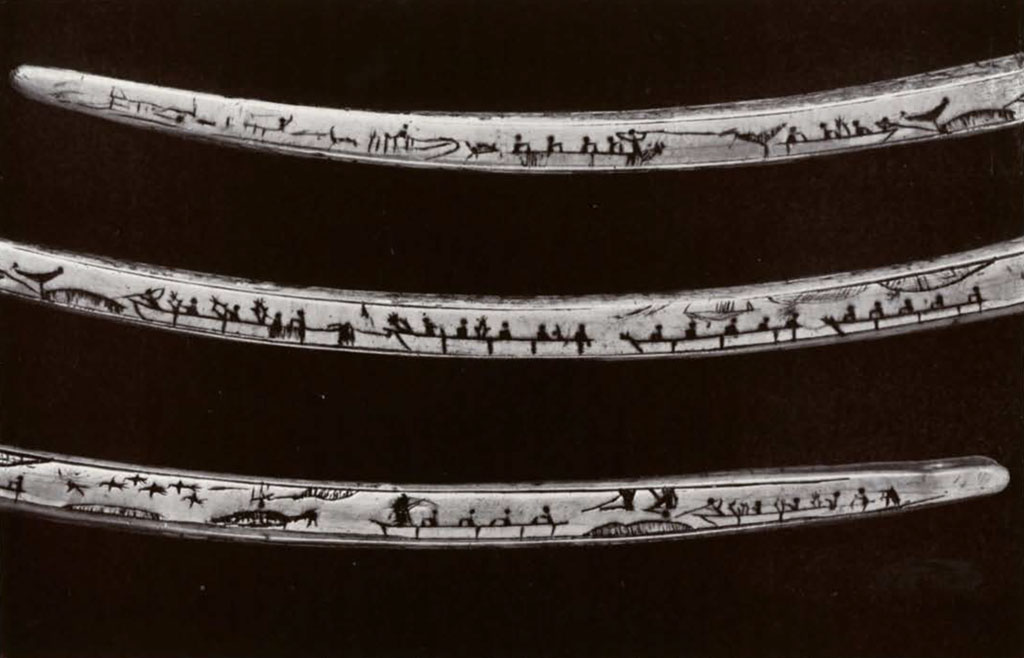
Museum Object Number: NA9387
Image Numbers: 12073, 12077, 12083
The illustrations on pages 266, 268, 270 and 272 show the four sides of the oldest and best bow in the collection, No. NA-9387. The provenience in unknown, but it is said to have been collected in 1816, very early in the history of white (Russian) contact with the Eskimo. It is completely covered with engravings, the four sides showing six different panoramas.
The principal or convex side has two complete scenes, one against either edge. The better one is a whaling scene. The squares on the two summer houses or tents may represent pieces of hide used for the covering. Figures in varied postures near the houses include one man holding several long staffs, possibly harpoons.
The rest of the panorama is illustrative of a whaling scene, in which eight umiaks, each with a crew of four men, are pursuing nine whales. Such a scene is, of course, quite imaginary; seldom is more than one whale sighted at a time and the capture of one is a joyful occasion.
Here we may pause a few moments to consider the practice of whaling among the Eskimo. The whale, while naturally inoffensive, is, because of his immense size, a formidable opponent for hunters with primitive equipment. Both on this account and because of the great value to the native of the whalebone, oil, blubber, meat and bones, whaling naturally became the most respected occupation among the Eskimo. Leaders of whaling parties are or become men of authority and respect and the occupation itself is surrounded with restrictions, tabus and ritual observances. All equipment must be scrupulously clean, for the whale “abominates slovenly ways,” no hammering may be done in the village and no woman may sew while the whaling party is out, and both before departure and immediately upon return, certain ceremonies must be observed.
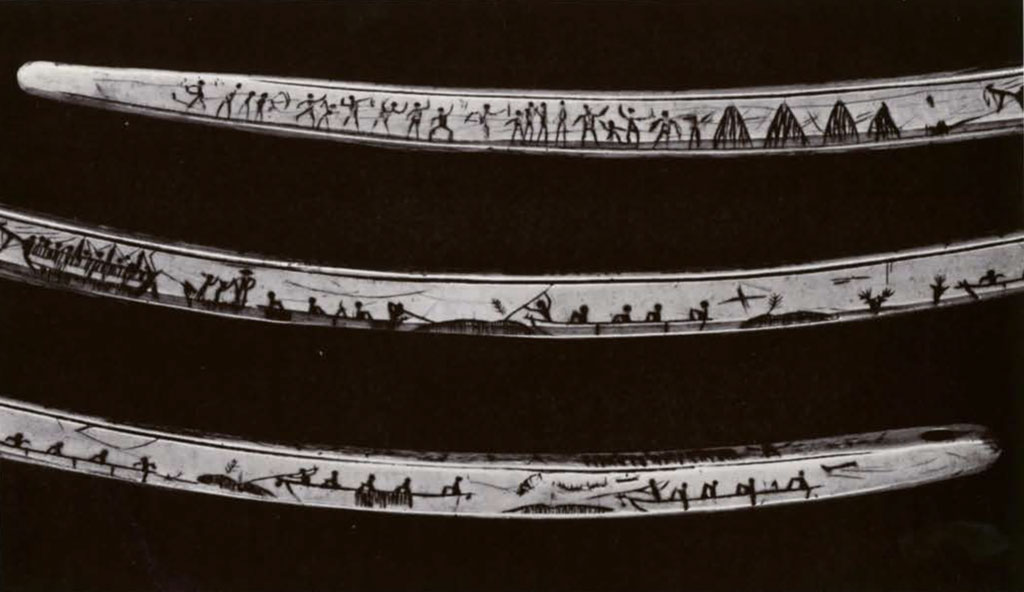
Museum Object Number: NA9387
Image Numbers: 12075, 12078, 12080, 12082
The whale principally sought is the “bowhead” or right whale, Balaena mysticetus, which normally attains a length of some fifty feet. This is the whale from which whalebone is secured as well as considerable quantities of whaleoil. The smaller beluga or white whale is less often pursued. Whaling is carried on from the umiak, the large open boat. Throughout the Eskimo area two boats are used, the kayak, a small covered boat used by a single hunter, always a man, and the umiak, a large open boat; both are made of sealskin or walrus-hide over a wooden framework. Among the Greenland Eskimo the umiak is exclusively a women’s boat and is rowed only by women, while in Alaska it is used by parties of men on hunting expeditions and, when thus employed, women are taken only when there is a dearth of men. On such occasions the women row with oars while the men paddle. On whaling expeditions, however, women are never taken and oars never used, at least among the Eskimo of Point Barrow.
The owner of the umiak and captain of the crew sits in the stern and steers with a large paddle while the rest of the crew, about eight in number, paddle. Today, some of these may carry rifles or even modern whale-guns shooting explosive lances, but the principal reliance today, as formerly the sole reliance, is on the harpooner who is stationed in the prow. Until the whale is neared the great harpoon rests in an ivory crotch in the bow, but as the umiak draws near the leviathan, the harpooner rises and plunges, not throws, the weapon into the beast. The detachable head with line fastened to it remains in the body of the whale, two inflated floats of sealskin being tied to the line so that the escape of the animal may be impeded and his position followed during his diving or “sounding” after the stroke. When he rises again another harpoon head which has been fitted to the shaft is plunged into him, as well as other lances, and when at last he succumbs he is towed ashore, “flensed” or skinned and cut up. The crew share the whalebone according to an agreed arrangement, but all within reach apparently are entitled to as much of the meat and blubber as they can secure.
The whaling panorama engraved on this side of the bowdrill shows most of these features, the umiaks, the steersmen, the paddlers —generally reduced to two in number—the harpooners with their weapons, the lines and floats and the whales, the breathing or “blowing” of the latter being generally depicted by a treelike symbol extending from the head. The differences are only minor. The three whale tails to the right probably form a record of the whales secured. The accepted symbolism that animals drawn facing away from the hunter represent those which escaped probably does not hold in the case of whales, all of these being attacked from behind, probably the universal method. At the far right a flight of seabirds is depicted.
On the opposite edge of this side of the bow a walrus hunt is portrayed. Here both umiaks with groups of men and kayaks with single hunters are shown, three of each, the kayaks attacking solitary animals, the umiaks those in groups. This feature may afford some clue as to the provenience of this bow, since Murdoch states that at Point Barrow he never saw the kayak used for walrus hunting, while Nelson, speaking of the Eskimo near the mouth of the Kuskokwim, mentions only the kayak in this connection. The walrus, Rosmarus obelus, whale, seal and caribou provide the Eskimo with practically all his necessities of life, the walrus producing tough hide, ivory and meat. He is hunted with a harpoon with detachable head which is thrown from boat or shore, a long line with an inflated float of sealskin being attached to the head. This float retards the flight of the animal and reveals his position, while the shaft is easily recovered. Today, of course, firearms are largely used, but have probably not yet entirely supplanted the harpoon, even with the most civilized Eskimo.
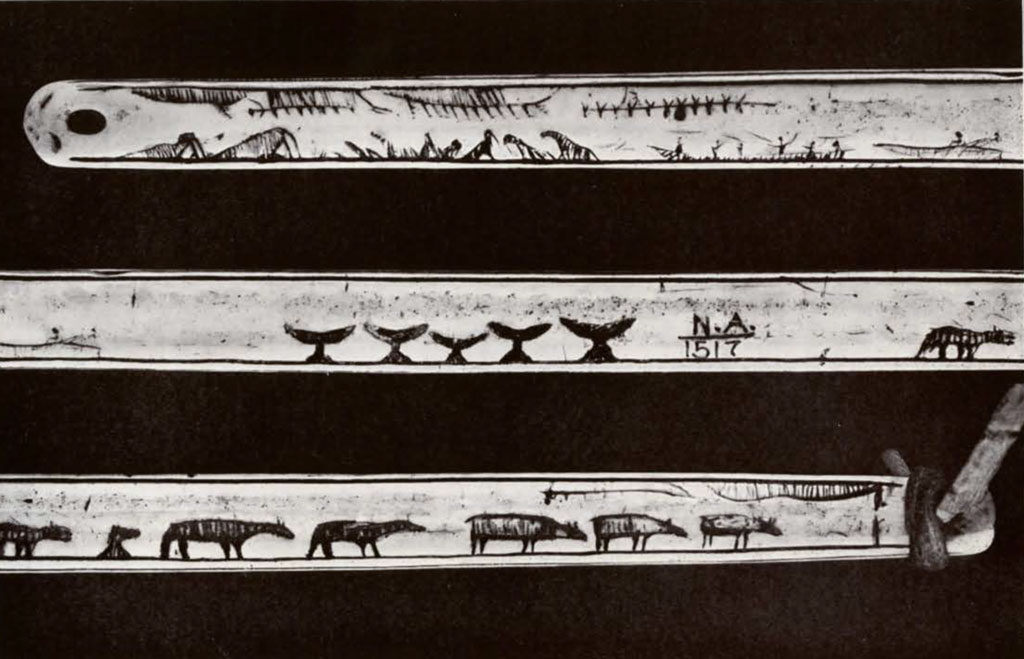
Museum Object Number: NA1517
Image Number: 12062-12065
The engraved scene shows, in lively action, most of the above-described features of walrus hunting, the confused, startled and fleeing animals, the harpoons with their coiled lines, the harpooners, frequently two in one umiak, and, in the case of the kayaks, the harpoon resting across the bow and the float behind the seat. It is not shown whether the occupants of the kayaks are using single or double-bladed paddles, both types being employed by the Eskimo.
On the concave side of the bow the engravings are somewhat confused and to some extent undecipherable because of the erosion caused by the now missing bowstring. They include another typical whaling scene in which five men in an umiak are harpooning a basking whale. In the center is a group probably representing a hunting scene on land. It may be presumed that the central figures in each of the two symmetrically balanced groups represent animals and the taller objects blinds behind which the hunters are hiding. But an interpretation of the scene as a battle is possible.
In the next scene, rival umiaks, one with four and the other with five occupants, are simultaneously harpooning a basking whale. The action shown with a minimum of strokes is most lifelike and praiseworthy. Finally, at the far right margin, two human figures, the first with arms folded and the other with arms upraised in a gesture for attracting attention, are separated by a large object of uncertain nature characterized by many parallel vertical lines. What object or concept known to the Eskimo this may represent is problematical; it may be entirely symbolical.
One of the two sides portrays on one edge typical lively whaling scenes, showing eight umiaks with from four to five occupants, four whales and a walrus. The attitudes of the paddles, steersmen and harpooners are most lively and naturalistic, although executed with the greatest economy of strokes and effort. The section of the panorama furthest to the left is eroded to the point of illegibility by the wear of the bowstring.
The opposite edge of this side bears a few figures of interest depicting the hunting of sea mammals. To the far left is a seated figure holding a long object up to his face. The resemblance is closest to a telescope, but it is very unlikely that the Eskimo knew of or possessed telescopes at the time of the manufacture of this bow. The interpretation of a pipe is objectionable inasmuch as Eskimo pipes are characterized by curving stems. The conical or pyramidal object before him may represent a hunting blind. Further to the right is seen a human figure dragging a walrus and further still are two whales and a carelessly engraved object of ill-defined nature.
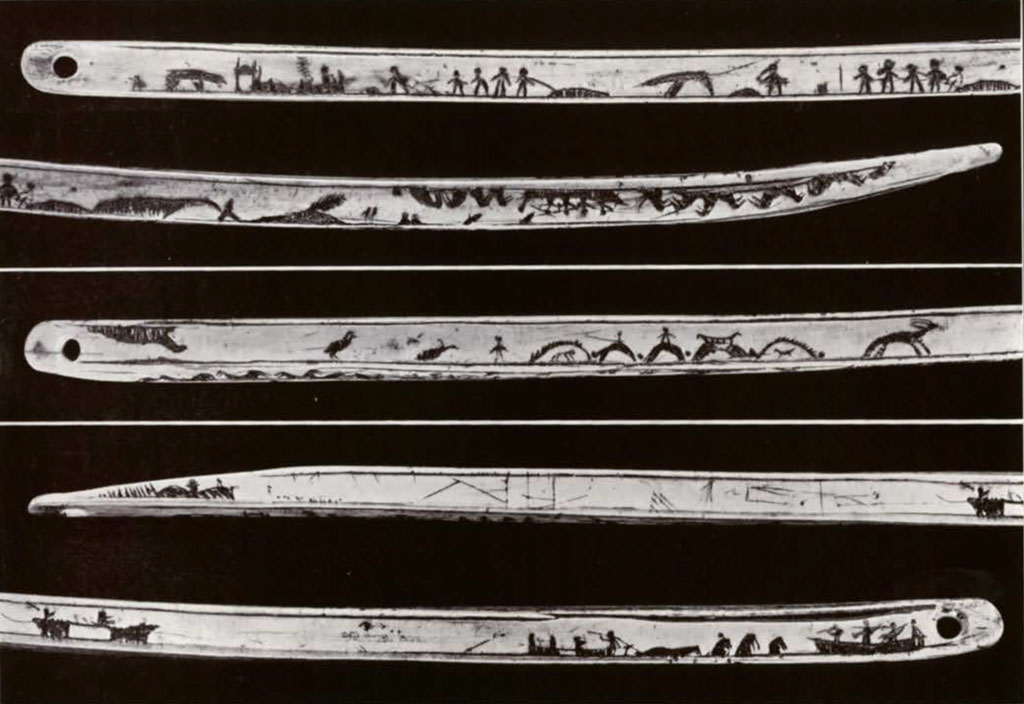
Museum Object Number: NA455
Image Number: 12046-12050
The most interesting of the six scenes on this bow is found on the opposite side, the action being full of life. To the left is apparently portrayed the excitement of a group of Eskimo in their shore village upon the visit of a sailing ship, presumably one of the earliest whalers. The whaling industry was introduced into the Bering Sea in 1848 and the first whaler visited Point Barrow in 1854. The inhabitants of the latter place are said never to have seen a white man until 1826, but the Eskimo to the south of Bering Strait came into contact with civilization nearly a century earlier, the first explorations having been by Captain Vitus Bering and Chirikov in 1741. Traders and trappers followed close in their wake, the first permanent settlement having been made in 1784. The native culture of the Eskimo of the Pacific Coast has therefore been much more affected by civilization than that of the natives of the Arctic Coast.
On the shore, beside four objects of sugar-loaf shape, the summer tents of the natives, are drawn twenty human figures in attitudes expressive of a boisterous welcome to the whalers which is obviously sincere, though whether in expectation of or as a result of a gift of “grog” is uncertain. Most of the figures are apparently dancing, their arms upraised in various attitudes. Some hold objects in their hands which may be guessed at as drums, shields and spears. The action, the proportions of the figures, the composition, are all admirable and surprising in primitive art and reveal a keen observation and conception of the human form in action. Many of them bear a strong resemblance to old Egyptian reliefs.
The whaling vessel is shown in the left center, an old-fashioned three-master with long bowsprit and martingale or “dolphin-striker,” riding high. A cable holds it to the shore. On board, ten human figures represent the crew, and three other figures are depicted in the ship’s boat which is fastened to the stern by its painter. The larger of these, wearing a hat, doubtless represents one of the ship’s officers. Each of the other two, probably sailors, is holding up a hand, probably in salute, a gesture which would certainly have attracted the attention of the observant Eskimo.
Another whaling panorama occupies the remainder of this side of the specimen, depicting five umiaks, each with four or five occupants, attacking four whales. The blowings of the leviathans, the exertions of the paddlers and the efforts of the harpooners are all well portrayed.
Two more bowdrills are shown on pages 274 and 276. The larger of these, NA-1517, from the Kuskokwim River, Alaska, is decorated on both convex and concave sides, but only the latter is shown, the engravings on the convex side being of slight importance.
To the left a lively walrus hunt is portrayed, ten walruses, an umiak with six men and a kayak with one occupant composing the scene. The drawing of the animals is especially good. In the center are five whale tails, probably the owner’s hunting record, and to the right seven animals, one shown by his head alone. The three in the rear have long tails and necks, and those in front shorter necks and diminutive tails. The former most probably represent wolves, the latter caribou.
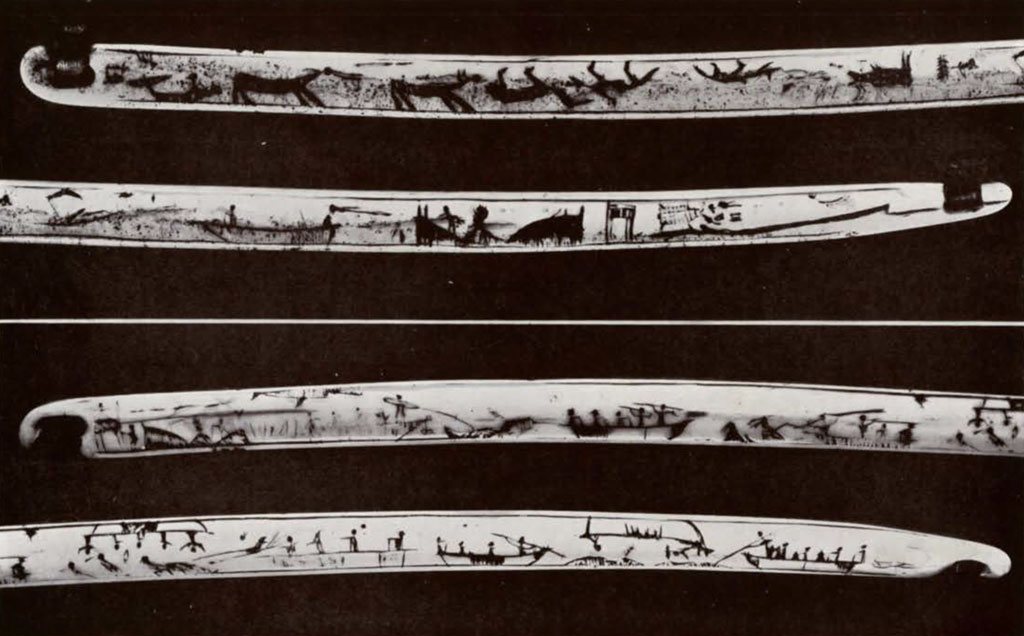
Museum Object Number: NA461
Image Number: 12058-12061
On the opposite edge are seen engravings at either side, but these are vague, somewhat worn down and probably unfinished. Human figures, whales and boats may be distinguished, one of the whales bearing a row of spines of undetermined nature on his back.
The other bowdrill on page 276, NA-455, from Cape Prince of Wales, is small and made with four relatively fiat sides of equal width. One of these is almost plain, but the other three are well decorated and are all illustrated here, comprising a total of eight scenes.
The more concave side portrays three scenes, small and widely separated—an Eskimo winter house, an umiak with two occupants, and a walrus hunt.
On the opposite more convex side of the bow is a scene radically different from any others and difficult to explain without the help of a native familiar with Eskimo symbolism, mythology and religion. For it is most probable that some esoteric ceremony or myth is here depicted. To the left are seen two single figures which the writer can interpret as nothing other than large two-headed birds. A human figure follows. The greater part of the scene is occupied by five hemispherical or semicircular objects which most probably represent houses, apparently of two types. Those on the two flanks are slightly larger and bear a row or covering of spines on the exterior and figures of animals on their faces which may represent either actual animals within the houses or figures painted on the side. The three central houses are slightly smaller and differently executed. On the roof of the central dwelling stands a human figure, that to the right bears an umiak or a sledge on its top and that to the left an object of unidentified nature. To the right of each house a dot has been incised. The scene terminates with the figure of an animal resembling a goat, but since the mountain goat appears to be unknown to the Eskimo some other animal must have been intended.
On the opposite edge of this side a solitary figure of a seal is seen.
One of the relatively flat sides of this bow is well decorated, the greater part of it being occupied by two continuous scenes separated by a medial line. To the left is a land scene showing a small human figure and a bear, both decidedly out of proportion, a food cache scaffold, a winter house with smoke arising and a man on the roof, a human figure approaching the house, four men dragging a walrus or other sea mammal, a large animal, probably a bear, and another man. The second section of this scene is maritime and portrays a group of four men dragging a sea mammal by means of a line. A large seal and a spouting whale are escaping, and beyond them may be descried four objects, probably inflated sealskin floats, in the water.
Against the other edge on this side, in inverted position, is shown a most lively scene of walrus hunting. This is unusually well executed, the delineation of the consternation of the surprised animals being most realistic. Like most Eskimo engravings, these scenes were probably records of hunts and adventures in which the owner participated, rather than purely decorative motives.
The last two bowdrills are those shown on pages 278 and 280, both of them with two principal faces, each well decorated with scenes familiar from the other engravings. The larger one, NA-461, from Cape Prince of Wales, the westernmost point of the American mainland, is considerably worn from use and many of the figures are indistinct. The lively action of men and animals in a walrus hunting scene on the convex side is well represented, the use of the throwing harpoons by the pair of men in the bow being especially good. The difference in the method of hunting the whale and walrus is accurately portrayed here, the man in the bow in the whaling scene being shown thrusting, instead of casting, the great harpoon, while the other occupants hold the sealskin floats ready to throw them overboard.
On the other edge of this side are three disconnected figures, an umiak with two men to the left, another umiak with five men in the center and a figure of a whale far to the right. The occupants of the central boat are endeavoring to attract attention by waving their arms and holding aloft some object, the cause of the excitement probably being the small object to the right, presumably a float indicating the position of a whale which has been harpooned.
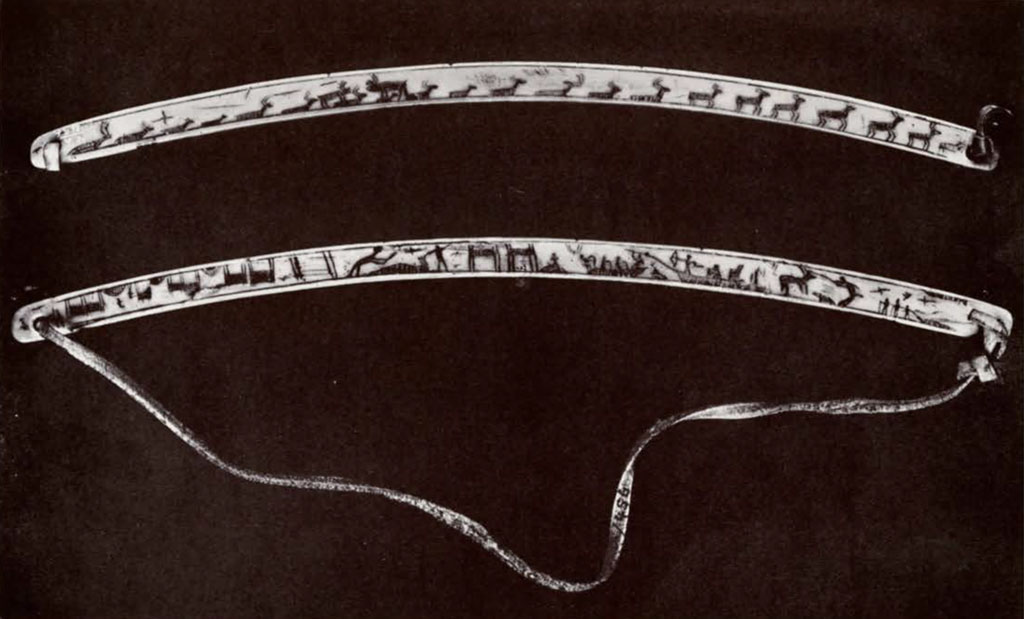
Museum Object Number: NA456
Image Number: 12054
The figures on the opposite, concave, side of this bow are confused and evidently drawn without definite plan or connection. Three main groups are seen, those at the two sides being based on one edge, that in the center on the opposite one. The three objects to the left comprise two quadrupeds and a figure on which anyone may place his own interpretation. The former are probably caribou, but the delineation is of the poorest. To the right are, besides several familiar objects, the pelt of an animal, probably a bear, and some markings of uncertain nature. Reversing the bow, on the other edge are drawn, from left to right, the tail of a whale, a man shooting with bow and arrow from behind a blind at a caribou and, to the right, three animals of which the first is probably a wolf, the second possesses some supernumerary appendages, while the third bears some resemblance to a Peruvian llama but none to any boreal animal within the ken of the writer.
Specimen NA-456, the last, comes from Nunivak Island, a small island off the west coast of Alaska between the mouths of the Yukon and the Kuskokwim. Its shape is somewhat different from that of any of the others, the thin edges being curved, the broad faces on which the engraving is done, flat. Three panoramas are incised on these two faces.
On one side is shown a line of caribou, twenty-three in all. The primitive artist has here had good opportunity to demonstrate his knowledge of animal anatomy and has depicted bucks, does and fawns by variations in size and details of horns. Two bucks seem to be about to fight and one of the reclining animals has its head turned and is looking backwards, an unusual attitude for the primitive artist to depict.
Upon the opposite face are portrayed two scenes, the larger one based on the concave edge, the smaller one inverted on the convex edge. Both are naturalistic but of rather rude execution. To the left, two human figures are working over a prostrate object; it may be hazarded that they are flensing a whale. Two food scaffolds are next seen with a human figure under one, then a low mound which may be a house with a human figure standing on the top. Two umiaks are next portrayed, apparently in mortal conflict, although the unidentified object between them may be the bone of contention and cause of the rivalry. The figure to the left, however, is hurling his lance with the help of a throwing stick, while the man in the prow of the boat to the right twangs his bow. Since the arrow is never used for hunting sea mammals and was the main weapon in war, it may be presumed that the scene represents a combat. Like most American Indian tribes in the days before they were put under governmental supervision, every group was in frequent, if not constant warfare with every neighboring group. In the case of the Eskimo this obtained not only between the Eskimo and the various Indian tribes of the hinterland, but also between the various groups of Eskimo. But, as general among the Indians, wars, though constant, were attended by few casualties. Open attack was seldom attempted; ambuscades of a few women or a lone hunter and stealthy nocturnal attempts on camps with a few deaths, wounds or captures were the usual methods of warfare. Such a scene of Homeric heroism as that depicted on the bow, open duelling between two bowmen in boats, would not be a common incident in Eskimo warfare and possibly occurred only in the imagination or day-dreams of the maker.
In the next scene of this panorama a man appears to be holding, with great effort and exertion, a jumping deer by a line attached to his horns. Between them is an animal, probably a dog. Unless the bow is of recent manufacture and represents a domesticated reindeer, it is difficult of explanation since no method of capturing caribou by means of lariats or lassoes is mentioned by any authority. This group ends with the depiction of three men dragging a seal.
At the other end of this side of the bow, inverted and based upon the opposite edge, is engraved a quiet village scene composed of three small hemispherical houses and seven large rectangular food storage scaffolds. Two lonely human figures are seen, one upon one of the houses, the other beside it.
Those who may be interested in delving more deeply and thoroughly into the subject of Eskimo art should consult especially “The Graphic Art of the Eskimo,” by Dr. Walter James Hoffman in the Report of the United States National Museum for 1895, pages 739968 with eighty-two plates. The general literature on the Eskimo is voluminous; every Arctic explorer has contributed to it and scattered and desultory descriptions of Eskimo life may be found in every work on polar travel. But the most complete and reliable accounts of Eskimo life written in a non-technical manner are probably to be found in the works of Knud Rasmussen. For more detailed and technical studies, Turner’s account of the Labrador Eskimo, Boas’s of the Central Eskimo, Murdoch’s of the Eskimo of Point Barrow and Nelson’s of the Eskimo of Bering Strait, all of them in the “Annual Reports of the Bureau of American Ethnology,” Smithsonian Institution, are the classical authorities.
1John Murdoch: Ethnological Results of the Point Barrow Expedition; Ninth Annual Report, Bureau of American Ethnology; Washington, 1892.↪

